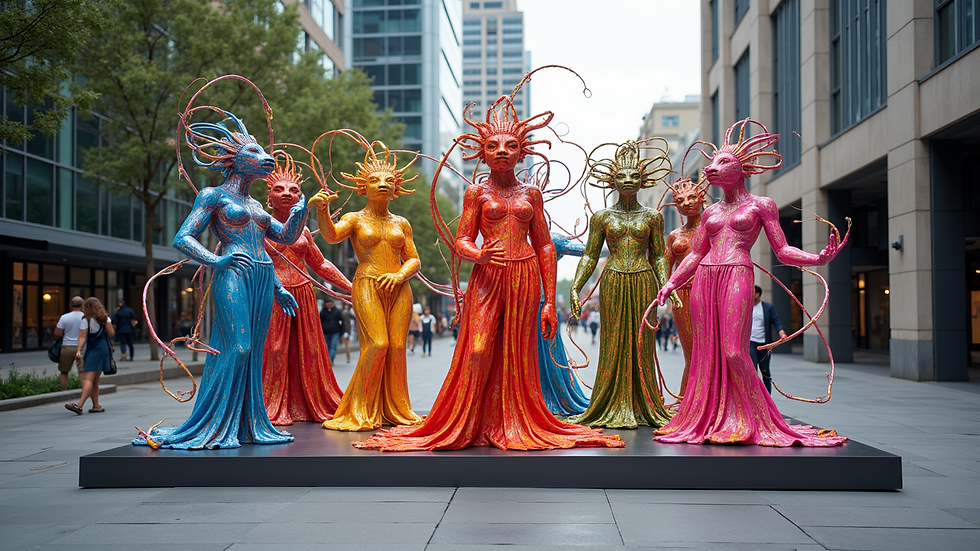Exploring the 10 Major Transformations in the Art Market Over the Last Decade
- Chiqui Rodriguez

- Sep 10
- 4 min read
The art market has transformed dramatically over the past decade. These changes have redefined how artists, collectors, and investors interact with art. From online platforms to sustainability efforts, these shifts have impacted the buying and selling of art and changed the overall landscape. By looking at the ten major transformations, we can gain valuable insights that can help artists, investors, and entrepreneurs adapt to this dynamic field.
1. The Rise of Online Art Sales
Online art sales have surged in recent years. Platforms like Artsy and Saatchi Art allow collectors to browse thousands of artworks from around the world. In 2022, online sales accounted for over 25% of total art sales, a significant increase from just 9% in 2019. The convenience of browsing and purchasing art online has democratized access, inviting a wider audience to invest in art.
2. The Emergence of NFTs
Non-fungible tokens (NFTs) have changed how we view and own digital art. Artists like Beeple made headlines by selling NFT artworks for millions, with his piece "Everydays: The First 5000 Days" auctioned for $69 million. This technology enables artists to prove ownership and authenticity using blockchain, providing them with new revenue streams. NFTs attract tech-savvy investors eager to engage with a booming digital art market that saw over $2 billion in sales in the first quarter of 2021 alone.
3. Increased Focus on Diversity and Inclusion
The push for diversity and inclusion in art has gained momentum, with galleries showcasing more works from artists of varied backgrounds. For instance, the Whitney Museum in New York dedicated its 2021 Biennial to underrepresented voices, showcasing works from 40% artists of color. This shift helps enrich the art landscape by challenging traditional narratives and offering a platform for marginalized voices.
4. Sustainability in Art Practices
Sustainability is now a key focus for artists and collectors alike. Many artists use eco-friendly materials to create their works. For example, British artist Chris Jordan uses recycled materials to craft stunning visual pieces. Collectors are increasingly seeking eco-conscious artworks, reflecting their values and commitment to environmental responsibility. Statistically, 72% of collectors prefer to support artists who prioritize sustainable practices, demonstrating a shift toward more ethical consumption.
5. The Growth of Art Fairs
Art fairs have become vital in the art market, offering galleries and artists exposure to global audiences. Events like Art Basel and Frieze attract numerous collectors and curators each year. In 2019, Art Basel alone welcomed over 90,000 visitors, allowing artists to build connections and gain visibility. This growth creates a bustling environment for networking while presenting new opportunities for collaborative projects.
6. The Influence of Social Media
Social media has revolutionized how artists promote their work. Platforms like Instagram allow seamless engagement with audiences, where artists showcase their portfolios directly. Art influencers can attract thousands of followers by sharing their creative journeys, leading to direct sales from their posts. For instance, artist @hannahbock_art gained over 50,000 followers in a year, using Instagram to drive art sales effectively.
7. The Rise of Art Investment Funds
Art investment funds are increasingly popular as a means for investors to diversify their portfolios. By investing in a collection of artworks, individuals reduce risk and gain exposure to valuable pieces. These funds have seen a nearly 15% annual return over the past five years, drawing attention from both seasoned investors and newcomers to the market. This trend reflects a growing recognition of art as a viable asset class.
8. Changing Collector Demographics
Art collectors have changed significantly over the last decade. Younger generations, particularly millennials and Gen Z, are entering the market with new preferences. A survey showed that over 60% of these young collectors prioritize art that makes a social impact. They also tend to favor artists who engage with digital platforms and contemporary themes, affecting the artworks being created and sold.
9. The Impact of Globalization
Globalization has expanded the art market into new regions. Emerging art scenes in cities like Lagos and Mexico City are gaining recognition. Artists like Njideka Akunyili Crosby from Nigeria have received international acclaim, showcasing the rich diversity of global art. This shift enriches the art landscape while opening opportunities for cultural exchange, making the market more vibrant and inclusive.
10. The Role of Technology in Art Creation
Advancements in technology have broadened how artists create their work. Many now incorporate digital tools like virtual reality and augmented reality into their artistic practices. For example, artists such as Casey Reas use code to create dynamic digital artworks. This integration of technology enhances creativity and offers new ways for audiences to engage with art, transforming the viewer experience.

Final Thoughts
The art market has undergone profound changes in the last decade, influenced by technology, shifting demographics, and a stronger focus on diversity and sustainability. These ten major transformations have reshaped how art is bought and sold and how artistic expression is understood. For artists and investors, staying informed about these trends is essential for thriving in this ever-evolving landscape. Embracing adaptability and creativity will be crucial for anyone looking to succeed in today's art world.
